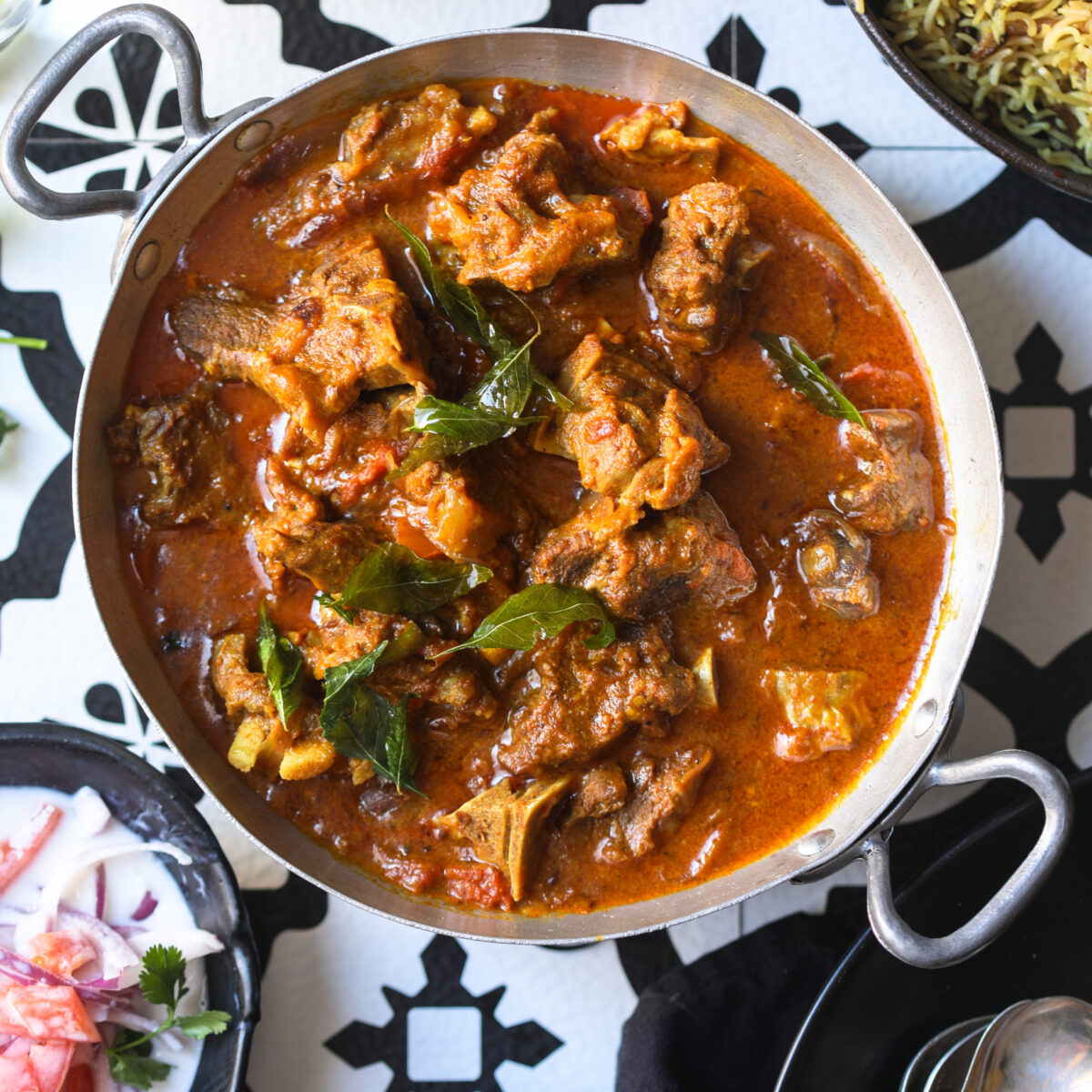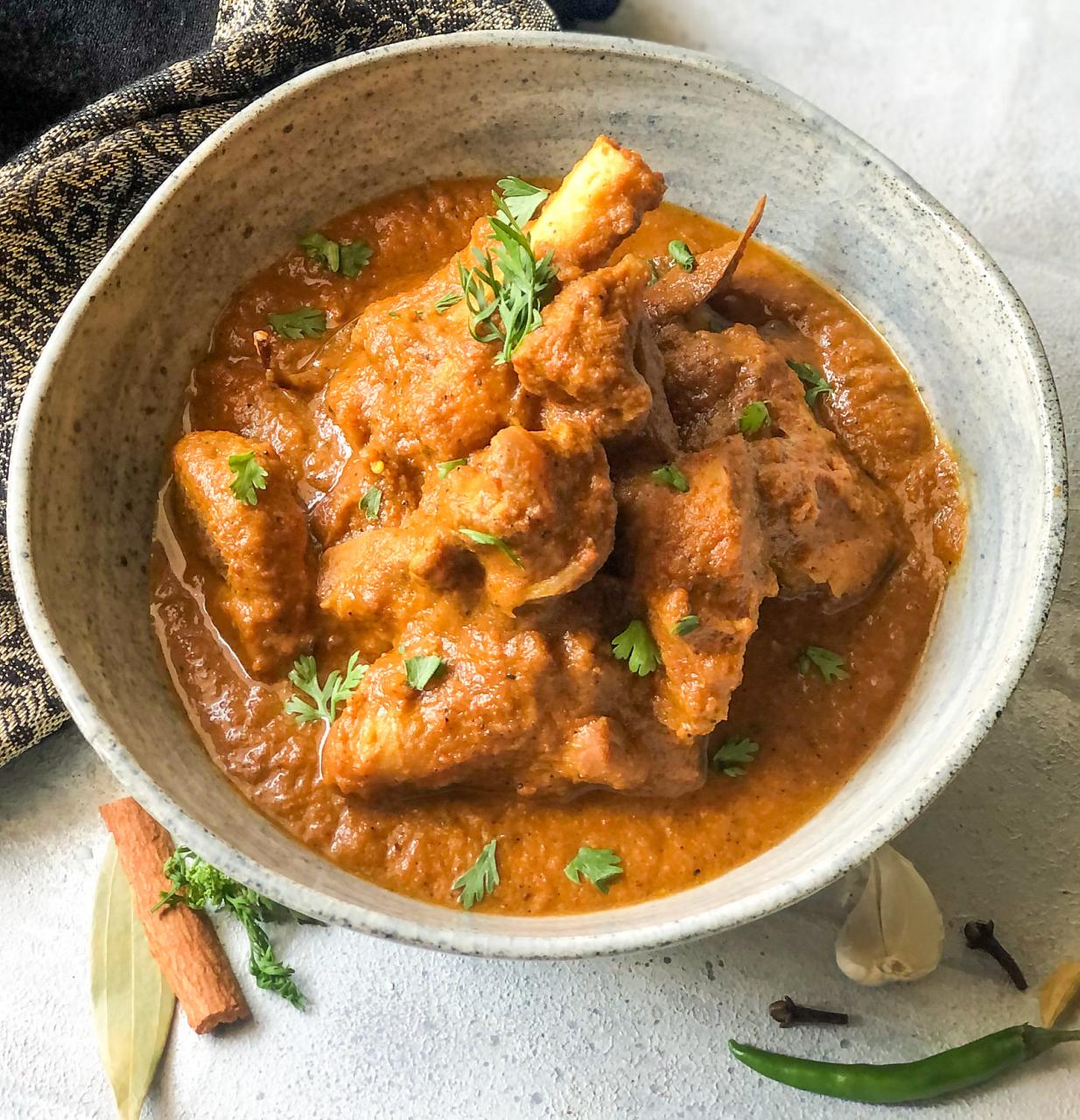Mutton Curry is a beloved dish that holds a special place in the culinary traditions of various cultures around the world, particularly in South Asia, the Caribbean, and parts of Africa. The essence of Mutton Curry lies in its slow-cooked, tender mutton pieces bathed in a rich, aromatic sauce that’s imbued with a blend of spices unique to each region’s culinary practices.
At its core, Mutton Curry embodies the deep, complex flavors achieved through the combination of spices like coriander, cumin, turmeric, red chili, garam masala, and more. These spices not only confer the dish its distinctive flavor but also contribute to its inviting golden to deep red color. Garlic, ginger, and onions often form the base of the curry, providing a foundational depth and sweetness that balances the spices’ heat.
The use of mutton – which refers to the meat of an adult sheep – is particularly prized for its rich taste and texture, adding a layer of luxury to the dish. Slow cooking is essential to ensure that the meat becomes succulently tender, allowing it to absorb the flavors of the spicy gravy fully.
Mutton Curry Recipe


Mutton Curry
Equipment
- 1 large bowl
- 1 large pot
Ingredients
- 1 pound boneless lamb cubed
- 1 teaspoon ground turmeric
- 2 teaspoons red chile powder divided
- 1 teaspoon salt
- 13/4 cups water divided
- 1 cup shredded fresh coconut or frozen, thawed to room temperature
- 1 onion quartered
- 2 tablespoons vegetable oil
- 1 onion chopped
- 3 garlic cloves minced
- 1 1-inch piece fresh ginger, peeled and minced
- 5 cilantro sprigs stems and leaves chopped, plus more leaves for garnish
- 1 tomato chopped
- 11/2 teaspoons ground coriander
- 11/2 teaspoons garam masala
Instructions
- In a large bowl, combine the lamb, turmeric, 1 teaspoon of chile powder, and salt. Toss to coat the lamb in the spices and let marinate at room temperature for 30 minutes.
- Place the marinated lamb in a large pot and add 1 cup of water. Place the pot over high heat and bring the water to a boil. Reduce the heat to low, cover the pot, and simmer for about 1 hour until the lamb is tender.
- In a food processor or blender, combine the coconut, onion quarters, and about 1⁄4 cup of water. Process until a smooth paste forms. Set aside.
- In a large skillet over medium heat, heat the vegetable oil.
- Add the chopped onion and cook for 4 to 5 minutes until the onion is softened and browned.
- Add the garlic and ginger and cook for 1 minute.
- Add the chopped cilantro and cook, stirring, until fragrant.
- Add the onion-coconut paste and fry for 3 to 4 minutes, until it just begins to brown.
- Add the lamb and any remaining liquid from the pot and cook for 5 minutes, stirring frequently.
- Add the tomato, remaining 1 teaspoon of chile powder, the coriander, and garam masala. Cook for 5 minutes more, stirring frequently.
- Pour about 1⁄2 cup of water into the skillet, cover it, and simmer for 10 minutes, stirring frequently, until the curry thickens. Taste and season with salt, as needed. Garnish with cilantro leaves before serving.
Notes
Cooking Tips about Mutton Curry

- Selecting the Right Cut: For a truly flavorful Mutton Curry, choose mutton cuts with bones, such as shoulder or leg pieces. The bones add depth to the curry’s flavor during the slow-cooking process.
- Marination: Marinate the mutton pieces for several hours, preferably overnight, in a mixture of yogurt and spices like ginger, garlic, cumin, coriander, and chili powder. This not only tenderizes the meat but also infuses it with robust flavors.
- Sautéing Onions to Perfection: The base of a good mutton curry often involves golden brown onions. Take your time sautéing the onions; they should be caramelized slowly over low heat to bring out their natural sweetness without burning.
- Balancing Spices: The essence of Mutton Curry lies in its spices. Use whole spices such as cardamom, cloves, cinnamon, and bay leaves for simmering in oil at the start, and ground spices for marinating the meat or adding to the curry as it cooks. Adjust the spice levels according to your taste.
- Slow Cooking: Mutton requires time to become tender. Cook the curry on a low flame for an extended period. This slow-cooking process allows the meat to become succulent and absorb the flavors fully. Pressure cooking can also be used to expedite this process without compromising too much on the texture.
- Thickening the Gravy: If your curry seems too thin, consider simmering it uncovered for a while longer. This allows excess water to evaporate, naturally thickening the sauce. Alternatively, a paste made from cashews or poppy seeds can be added as a thickener.
- Making Use of Acidic Ingredients: A bit of tanginess can enhance the overall flavor profile of the curry. This can be achieved by incorporating tomatoes into the base gravy or by adding a splash of lemon juice towards the end of the cooking process.
- Resting Time: After the curry is cooked, let it rest for at least half an hour before serving. Resting allows the flavors to meld together more harmoniously.
- Garnish: Just before serving, garnish the mutton curry with fresh cilantro leaves. For a touch of richness, a swirl of cream or a sprinkle of garam masala can be added.
- Accompaniments: Serve your Mutton Curry with steamed rice, naan, roti, or parathas to soak up the delicious gravy. A side of raita or a simple onion salad can complement the spicy flavors of the curry.
Serving suggestions about Mutton Curry
- With Steamed Basmati Rice: The classic and perhaps most popular way to serve Mutton Curry is alongside fluffy, steamed basmati rice. The mildness of the rice pairs beautifully with the spices of the curry, making for a harmonious blend of flavors in each bite.
- With Indian Breads: Serve Mutton Curry with various types of Indian bread such as roti, naan, or chapati. These breads are perfect for scooping up the curry and enjoying the full flavor of the sauce along with the tenderness of the mutton.
- As Part of a Thali: Incorporate Mutton Curry into a thali, a platter featuring a variety of dishes. Include vegetarian sides like saag (spinach), dal (lentil soup), and raita (yogurt-based side dish) to provide a balanced and expansive meal experience.
- With Jeera Rice: Jeera (cumin) rice, with its subtle nutty flavor, makes an excellent pair with Mutton Curry. The cumin seeds in the rice add a nice aroma and taste that complements the bold flavors of the curry.
- Biryani Style: Layer partially cooked rice over the Mutton Curry and cook them together (Dum style) to make a Mutton Biryani. This infuses the rice with the curry’s flavors, creating a one-pot meal that’s aromatic and flavorful.
- With Pulao: A lightly spiced pulao, containing peas or mixed vegetables, offers a slightly more flavorful rice option without overpowering the taste of the Mutton Curry. It can add texture and variety to the meal.
- Side Salad: To balance the richness of the Mutton Curry, serve it with a refreshing side salad made of cucumbers, tomatoes, onions, and a sprinkle of lemon juice and chaat masala. This helps cleanse the palate between bites.
- Pickles and Chutneys: Accompany Mutton Curry with tangy pickles or chutneys to add a zesty flavor contrast. Mango pickle, lime pickle, or mint chutney can enhance the overall taste experience.
- Dessert Pairing: After a hearty meal of Mutton Curry, offer a sweet and cooling dessert like kheer (rice pudding) or gulab jamun to complete the dining experience on a delightful note.
Top 5 FAQs about Mutton Curry

- What is Mutton Curry? Mutton Curry is a renowned dish that features slow-cooked, tender mutton pieces in a rich and aromatic sauce made from a blend of spices unique to the culinary traditions of various regions around the world. The key spices include coriander, cumin, turmeric, red chili, and garam masala, which give the dish its distinctive flavor and color.
- Which cut of mutton is best for making Mutton Curry? For a flavorful Mutton Curry, choosing cuts with bones, such as shoulder or leg pieces, is recommended. The bones add depth to the curry’s flavor during the slow-cooking process, enhancing the overall taste and richness of the dish.
- How can I make my Mutton Curry more flavorful? Marinating the mutton pieces overnight in a mixture of yogurt and spices like ginger, garlic, cumin, coriander, and chili powder can significantly improve the dish’s flavor. This step not only tenderizes the meat but also infuses it with robust flavors. Additionally, sautéing onions until they are golden brown and caramelized adds a foundational depth that complements the spices’ heat.
- Is it possible to adjust the spiciness of Mutton Curry? Yes, the spice levels in Mutton Curry can be adjusted according to personal taste. The amount of red chili powder or green chilies can be altered to increase or decrease the heat without substantially affecting the dish’s overall flavor profile.
- What are some suitable side dishes to serve with Mutton Curry? Mutton Curry pairs beautifully with steamed basmati rice, Indian breads such as roti or naan, or even jeera rice for those seeking a slightly more aromatic option. To balance the spiciness, consider serving it with a side of raita or a simple onion salad. For dessert, a sweet and cooling option like kheer (rice pudding) or gulab jamun can complement the rich flavors of the curry.
Mutton Curry, with its rich tapestry of flavors and deeply satisfying essence, represents a culinary masterpiece revered across different cultures. Its preparation is both an art and a testament to the diverse culinary traditions that have perfected this dish over centuries. The slow-cooked, tender mutton pieces, simmered in a vibrant and aromatic gravy enriched with a medley of spices, embody the complexity and depth of flavors that are the hallmarks of a great Mutton Curry.

Leave a Reply